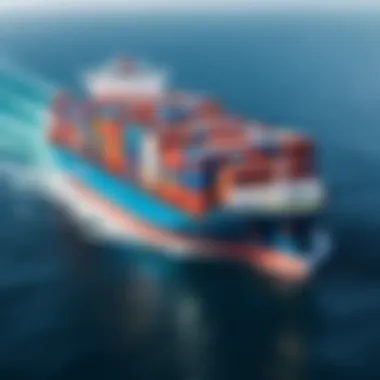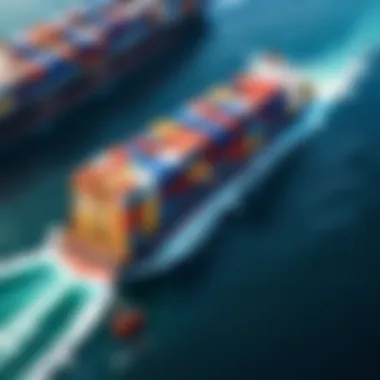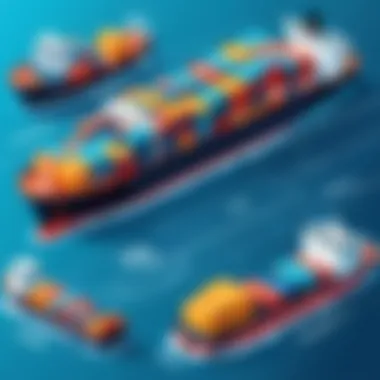Ocean Freight Payment: Insights for Global Trade


Intro
When it comes to global trade, ocean freight payment processes play a vital role in ensuring that goods move smoothly from one port to another. Yet, many businesses overlook the intricacies involved in these transactions. Getting a grip on the nuances of ocean freight payment not only streamlines logistics but also enhances cost management and optimizes cash flow.
Understanding this aspect can be likened to navigating a ship through foggy waters—having precise insight guides the way, avoiding potential pitfalls.
Technological Research Overview
As technology advances, so too does its influence over ocean freight payments.
This section explores key innovations, their impact on business operations, and looks ahead to future trends that can shape the landscape further.
Recent Technological Innovations
In recent years, technologies like blockchain, electronic data interchange (EDI), and automated payment systems are revolutionizing ocean freight payment methods. Companies employing blockchain technology benefit from increased transparency, greater security, and reduced friction in transactions. For instance, Maersk, the world’s largest shipping line, has harnessed blockchain to streamline paperwork, essentially cutting down delays which plague traditional shipping logistics.
Impact on Business Operations
The incorporation of these technologies changes how businesses operate. With automated payment processing and improved monitoring systems, companies can now manage their cash flow with remarkable precision. Delivery schedules that used to require extensive manual tracking can now be updated in real time, promoting greater efficiency. Shipments are no longer just numbers; they become actionable data points that inform strategic decisions.
Future Technological Trends
Moving forward, several trends are likely to gain traction in ocean freight payment processing. The integration of artificial intelligence (AI) is poised to enhance predictive analytics, allowing companies to foresee potential delays or payment issues before they arise. Adoption of smart contracts—self-executing contracts coded onto blockchain—offers promising prospects for secure and efficient transactions, potentially revolutionizing the entire process.
"With each technological leap, businesses unlock efficiencies that were previously unfathomable, changing the very fabric of global trade."
Data Analytics in Business
Data analytics has emerged as a cornerstone in optimizing ocean freight payments. The ability to analyze vast amounts of data enables companies to make informed decisions that can result in significant cost savings and overall efficiency.
Importance of Data Analytics
Utilizing data analytics in ocean freight payment is not just about number-crunching but rather understanding trends that can affect future operations. Insights gained can influence supplier relationships and help in predictive cost modeling, ensuring robust financial planning.
Tools for Data Analysis
A variety of data analytical tools are available to businesses dealing with ocean freight. Platforms like Tableau and Microsoft Power BI convert complex shipping data into actionable insights. Pairing these tools with machine learning algorithms allows businesses to refine their logistical strategies continuously.
Case Studies on Data-Driven Decisions
A notable example includes a multinational retail brand that adopted data analytics in freight payment processes. By analyzing shipping patterns and payment cycles, the brand identified discrepancies that resulted in cost overruns. Adjusting their payment terms based on data-driven insights led to a 15% reduction in shipping costs.
Cybersecurity Insights
With the rise of technology in ocean freight payments, cybersecurity has become a paramount concern. Protecting sensitive financial data from potential breaches is essential to maintain trust and operational integrity.
Threat Landscape Analysis
The threat landscape is evolving, with cybercriminals increasingly targeting maritime operations. An attack on payment systems can lead to severe financial losses and disruption of services. Understanding these threats is the first step toward developing robust countermeasures.
Best Practices for Cybersecurity
To fortify systems against potential breaches, businesses should implement the following:
- Conduct regular security audits.
- Train staff on recognizing phishing attempts.
- Utilize end-to-end encryption for sensitive data.
- Establish dual-authentication protocols.
Regulatory Compliance in Cybersecurity
Regulatory frameworks, such as the General Data Protection Regulation (GDPR), dictate strict compliance when dealing with customer data. Businesses must prioritize adherence to prevent hefty fines and potential reputational damage.
Artificial Intelligence Applications
Artificial intelligence is changing the game for ocean freight payment processes. From automating mundane tasks to predicting market shifts, AI offers a multitude of applications.
AI in Business Automation
By integrating AI into their processes, businesses can automate routine payment confirmations and reduce human error. For instance, companies can employ AI algorithms to streamline invoice approvals, which accelerates payment cycles and improves supplier relationships.
AI Algorithms and Applications
AI applications extend beyond automation; they encompass predictive analytics tools that assist businesses in forecasting payment trends and managing risks associated with currency fluctuations. Companies like IBM are developing sophisticated algorithms that analyze historical data, helping organizations make better payment decisions.
Ethical Considerations in AI
In the race to capitalize on AI, ethical considerations should not be overlooked. Businesses must ensure that their use of algorithms is transparent, avoiding biases in decision-making that could unfairly impact certain supplier relationships.
Industry-Specific Research
Different industries face unique challenges regarding ocean freight payments. Understanding industry-specific needs can lead to more tailored solutions.
Tech Research in Finance Sector
The finance sector is increasingly exploring tech solutions that can enhance transaction security and speed. Financial entities are employing fintech solutions to streamline payment processes, thereby enhancing liquidity and reducing risk.


Healthcare Technological Advancements
In healthcare, timing is crucial, especially with perishable goods or urgent medications. Advancements in tracking technologies and automated payment systems are vital to ensure timely delivery without compromising quality.
Retail Industry Tech Solutions
Retail has seen substantial tech adoption in payment processing, as integration with e-commerce platforms allows for a seamless payment experience. This not only enhances customer satisfaction but optimizes supply chain management.
Understanding the ever-evolving landscape of ocean freight payments is essential for businesses looking to thrive in an increasingly interconnected world. By leveraging technology, data analytics, and industry insights, organizations can navigate the financial waters with confidence.
Understanding Ocean Freight Payment
Ocean freight payment serves as the backbone of global commerce, influencing not just the efficiency of shipping processes but also the financial health of businesses engaged in international trade. As supply chains stretch across continents, the methods by which goods are paid for during transit become crucial. Understanding how these payments function can enhance a company’s logistical strategies and ultimately lead to significant cost savings.
Definition and Importance
When we talk about ocean freight payment, we are looking at the financial transactions that take place between parties involved in the shipping of goods across oceans. This includes freight charges, insurance costs, customs duties, and other fees that must be settled prior to or upon arrival at the destination port. The importance of understanding these payments cannot be overstated.
For one, it lays the groundwork for accurate budgeting and financial forecasting. In the volatile seas of global trade, costs can fluctuate based on fuel prices, port fees, or even geopolitical events. Knowing these elements allows businesses to approach logistical planning with a clearer perspective.
Furthermore, a solid grasp of payment definitions is essential to avoid disputes. Different terms like Free on Board (FOB) or Cost, Insurance, and Freight (CIF) stipulate who covers costs at various points in the shipping process. Without a clear understanding, companies may end up paying more than they anticipated or finding themselves entangled in legal disputes.
Role in Global Trade
The role of ocean freight payment in global trade extends beyond mere transactions; it embodies the trust and coordination among international partners. Ocean freight payment facilitates smoother trade relationships and efficient supply chain operations. Because trade often involves multiple stakeholders—such as shippers, consignees, and financial institutions—there is a necessity for a structured payment mechanism that can accommodate this complexity.
- Boosting International Relations: Timely payments often lead to better service from carriers and suppliers. A reputation for prompt payments can enhance business relationships and lead to favorable terms.
- Mitigating Risks: Understanding various payment terms and methods helps businesses navigate potential pitfalls. Issues such as currency fluctuations, fraud, and unexpected delays can be strategically managed when companies are well-informed.
- Economic Impact: On a macro level, efficient handling of ocean freight payments contributes to fluid global trade. It reduces bottlenecks at ports and facilitates the movement of goods, which in return boosts economies worldwide.
"In the interconnected world of trade, every payment made is a bridge, linking products to markets and suppliers to consumers."
Key Components of Ocean Freight Payment
Understanding the key components of ocean freight payment is crucial for businesses engaged in international trade. These elements shape the flow of goods and the financial aspects tied to maritime logistics. By having a firm grasp of this domain, organizations can better manage their shipping strategies, avoid unnecessary costs, and remain competitive in a global market.
Payment Terms
Incoterms Overview
Incoterms, or International Commercial Terms, determine who is responsible for various costs at different points in the shipping process. They are essential in defining the obligations of buyers and sellers. Incoterms make it clear who is in charge of freight costs, insurance, and liability during transit. This clarity helps avoid potential conflicts and misunderstandings.
One of the most prominent characteristics of Incoterms is their adaptability to different types of transactions. For example, the specific term "FOB" (Free On Board) indicates that the seller delivers the goods on board the vessel, and the buyer takes responsibility once the goods cross the ship's rail. This clarity is a major reason why Incoterms are a favored tool in ocean freight payment.
However, one unique feature of Incoterms to consider is their periodic updates every ten years. This means that businesses must stay informed about changes to continue making the best choices in freight dealings. Similarly, their inherent complexity may lead to misinterpretation, which can be a disadvantage if not carefully navigated.
Trade Terms Explained
Trade terms, encompassing Incoterms, provide a broader framework for how transactions are structured and executed. They serve as a compass for international dealings, dictating the path taken from the buyer's hands to the seller's.
What makes trade terms beneficial is how they create a common understanding across borders, reducing miscommunication. They're like a universal language of shipping, ensuring everyone knows their roles. A unique aspect here is how trade terms often reflect the nuances of local regulations. This can either be an advantage, simplifying negotiations within certain regions or a drawback if stakeholders don't keep up with regional variations.
Impact on Freight Costs
The impact of payment terms on freight costs can’t be understated. These terms dictate when and how costs are incurred, influencing overall budget calculations. For instance, choosing an EXW (Ex Works) term can significantly lower initial shipping costs for sellers but may lead to higher expenses for buyers who assume all charges post-pickup.
The primary characteristic of these payment terms is their potential to alter the financial landscape of shipping. By having knowledge of how terms affect costs, businesses can choose better options tailored to their needs. However, their downside lies in the possible hidden costs that can arise later in the transport process, emphasizing the importance of thorough upfront discussions.
Payment Methods
Bank Transfers
Bank transfers stand as one of the most widespread methods for ocean freight payments. Businesses appreciate this method for its simplicity and reliability. A key characteristic of bank transfers is their ability to facilitate transactions across different currencies, thus catering to international dealings.
The unique advantage of bank transfers is that they offer a direct line of communication between the buying and selling parties through their banks, reducing the scope for errors. On the flip side, one downside is the potential for transaction delays, particularly with international transfers that might go through several banks.
Letter of Credit
A letter of credit is a document issued by a bank to guarantee a seller's payment upon meeting certain conditions. This payment method plays a vital role, especially in high-value transactions, providing security to both parties.
The primary appeal of letters of credit comes from their protection against buyer default, making it a trustworthy option. Their unique feature is also the requirement for financial institutions to scrutinize documentation before payment, which adds a layer of security. Nevertheless, this added layer can prolong transaction times, potentially frustrating parties eager for rapid resolution.
Documentary Collections
Documentary collections represent another preferred payment method in ocean freight. Here, the seller’s bank handles the shipping documents and only releases them to the buyer upon payment. What sets this method apart is its balance between risk and ease of use.
A key characteristic is that it offers a middle ground, not as rigid as letters of credit but also more secure than mere invoices. This layered approach to payment is appealing, allowing for manageable risks. However, it still has weaknesses, such as dependency on the good faith of the buyer, which could lead to disputes if ships carrying goods experience delays.
Currency and Exchange Considerations
Currency Risk Management
Currency risk can significantly affect ocean freight payments. Price fluctuations in foreign exchange rates can lead to unexpected increases in shipping costs. Effective currency risk management strategies help businesses mitigate these risks, safeguarding their profit margins.


The chief characteristic here is the proactive approach—companies often use hedging techniques to lock in favorable exchange rates. A unique advantage of this strategy is its capacity to provide predictability in budgeting. On the downside, however, the hedging process can add complexity to financial management, requiring specific expertise.
Converting Payment Methods
Finally, converting payment methods can also impact international shipments. Some methods might be more compatible with specific currencies or countries, leading companies to consider options for easy conversion.
The key characteristic is flexibility; organizations that can switch payment methods as necessary tend to navigate shipping partnerships with greater ease. An advantage of this adaptability is it encourages positive relationships with overseas suppliers. However, it does come with challenges; variations in fees can add complexity, necessitating thorough research when implementing these changes.
Processes in Ocean Freight Payment
The realm of ocean freight payment is a multilayered process that is critical not only for ensuring smooth logistics but also for fostering relationships among stakeholders in global trade. Understanding the several layers of processes in ocean freight payment offers businesses the chance to streamline operations, minimize errors, and optimize cash flow management. With the remarkable growth of international trade, grasping these intricate processes is no longer just an added advantage; it is a necessity!
Initiation of Payment
Invoice Generation
One important step in the initiation of payment is invoice generation. The invoice acts as a formal request for payment, detailing the services rendered, costs involved, and payment terms. This document is not just a piece of paper; it represents the financial transaction of the entire shipment process. Having a well-drafted invoice is significant in facilitating swift payments, as it clearly lays out what each party owes and is owed.
One primary characteristic of a good invoice is clarity. When an invoice is straightforward and easily understood, the chances of disputes diminish significantly. This makes it a popular choice for many in the industry. Unique to invoice generation is the ability to include multiple payment terms, such as early payment discounts, which can incentivize quicker transactions. However, an issue can arise if the invoice is poorly structured, leading to confusion or delay in payment processes.
Verification Protocols
Verification protocols follow closely behind invoice generation. It involves confirming the accuracy of invoices and ensuring that all parties agree on the mentioned amounts and terms. This step is often overlooked, yet it is crucial for avoiding potential payment disputes later on. A critical characteristic of robust verification protocols is their ability to cross-check details across various documents, such as shipping confirmations and customs declarations.
Given that verification can be automated through software solutions, it has gained popularity among businesses striving to minimize human error. Nonetheless, while technology can streamline processes, it’s essential to maintain human oversight to catch unique discrepancies—something an algorithm may not recognize. This balance between tech and human input is key to successful verification protocols.
Processing Payments
Digital Payment Solutions
With the rise of technology, digital payment solutions have transformed how payments are processed in ocean freight. These solutions allow for quick transactions, enhancing efficiency in what can sometimes be a sluggish process. Its key characteristic is speed, enabling payments to be completed in less time than traditional methods. For this reason, digital payments have become greatly beneficial in today's fast-paced shipping environment.
One unique feature of these solutions is their adaptive nature, allowing users to switch payment methods based on the transaction's specifics. However, the flip side is vulnerability to cyber threats, which can cause significant financial loss and disruption. Thus, while adopting these modern solutions, businesses must avoid cutting corners on security measures.
Third-Party Payment Platforms
Third-party payment platforms, such as PayPal and Stripe, serve as intermediaries between buyers and sellers, allowing efficient processing of payments. Their characteristic lies in their ability to offer a single platform for multiple currencies, making them particularly favorable in international trade. Utilizing these platforms simplifies the process and adds a layer of credibility, which may facilitate trust between trading partners.
A notable aspect of using third-party platforms is that they can save businesses the hassle of handling multiple currencies. Nevertheless, it is crucial for users to be aware of potential fees, as these services can often impose costs that might not be immediately apparent, impacting the overall transaction value.
Finalizing Transactions
Confirmation of Payment
After payments are processed, confirmation of payment processes occurs. This step is vital, as it involves both parties acknowledging that the payment transaction has taken place. One key characteristic of confirmation is its ability to provide peace of mind; each party knows that obligations are being met. This step has grown in importance, especially with digital transactions, where confirmations can often be received instantly.
The unique aspect of this process is its role in maintaining financial records. A swift confirmation can sometimes serve as proof in case of disputes. However, the downside can be complications from mismatched confirmations, leading to confusion between partners. Hence, maintaining clear records is crucial.
Record Keeping
Last but not least, record keeping cannot be missed in ocean freight payment processes. Accurate and systematic recording of transactions is essential to financial management, providing a complete historical view of dealings. A significant characteristic of effective record keeping is organization; well-maintained records can be quickly accessed and reviewed, offering valuable insights over time.
The unique benefit here lies in its potential for audits and decision-making. On the flip side, poor record keeping can lead to financial discrepancies and loss of trust among partners. It is advisable for businesses to allocate resources to ensure that record-keeping systems are not only efficient but also robust enough to handle varying complexities in transactions.
Understanding these processes helps businesses ensure they don’t find themselves in a pickle when it comes to payments, enabling a smoother overall experience in the high-stakes world of ocean freight.
Challenges in Ocean Freight Payments
In the realm of ocean freight, payment processes are as critical as the shipping itself. Navigating the waters of payment can be a tricky endeavor, fraught with various challenges that can affect cash flow, logistics, and the overall efficiency of operations. Knowing these hurdles is essential for businesses aiming to establish a robust shipping strategy. Recognizing potential obstacles helps in implementing preventative measures that can save time and money.
Exposure to Fraud
Fraud is an ever-present risk in ocean freight payments. The complexity of transactions and the multiple parties involved create a fertile ground for fraudulent activities. Scammers often exploit this environment by creating fake invoices or impersonating legitimate companies. For instance, a shipping company might receive a payment request from someone posing as their supplier, leading to substantial financial losses.
To combat these threats, companies need to adopt stringent verification protocols. Here are a few strategies:
- Regular Audits: Conduct periodic reviews of financial transactions to identify any discrepancies.
- Verification of Details: Always confirm payment requests via direct communication with known contacts in the supplier's organization.
- Use of Technology: Implement software solutions that can flag unusual patterns or activities.
"In freight, just like in life, it pays to keep your guard up. Don't let a smooth talker lead you into the storm."
Delays and Disputes
Delays in ocean freight payments can cascade into serious operational issues. When payments don't go through as planned, it can halt shipments, causing inventory shortages and missed opportunities. Disputes often arise from misunderstandings over terms, incorrect billing, or unexpected fees. For example, a cargo may be held at the port due to a payment dispute, which could have been avoided with clearer communication and proper documentation.
To mitigate delays and disputes, organizations should focus on:
- Clear Communication: Ensure all parties are on the same page regarding payment terms and logistics.
- Document Everything: Keep thorough records of agreements, invoices, and communications.
- Dispute Resolution Roadmap: Establish a clear process for resolving disputes to ensure quick resolution.
Regulatory Compliance


Staying compliant with regulations is an ongoing challenge in ocean freight payments. Legal requirements vary significantly by region and can change frequently, which adds another layer of complexity. Companies that fail to meet compliance standards may face fines or restrictions that could impact their bottom line.
To manage these complexities, businesses can take several proactive steps:
- Stay Informed: Regularly review regulatory updates in regions where you operate. Websites such as Wikipedia and Britannica can be useful resources.
- Compliance Training: Provide training for finance and logistics teams on the latest compliance requirements.
- Engage Experts: Consider hiring compliance specialists or consultants to ensure adherence to all relevant laws.
By addressing these challenges head-on, businesses can navigate the complexities of ocean freight payments effectively, safeguarding their operations and improving their financial health.
Advancements in Payment Technologies
Payment technologies have seen rapid changes, especially in the realm of ocean freight. These advancements redefine how transactions are conducted, enhance security, and streamline operations in the maritime industry. With increasing complexity in logistics, it becomes crucial to embrace these innovations for better efficiency and risk management.
Blockchain Integration
Integrating blockchain technology into ocean freight payments can revolutionize the sector. Blockchain offers a decentralized ledger where all transaction records are immutable and transparent. This means that every stakeholder involved can view the transaction history. This level of transparency is essential in building trust among parties, reducing disputes over payments, and ensuring accountability.
One notable advantage of blockchain is its potential to speed up the payment process. Traditionally, payments involve multiple intermediaries, which can result in delays. With blockchain, payments can be verified and executed in real-time, significantly reducing the time taken from initiation to finalization.
There’s also a broader implications for fraud prevention. Since all transactions are recorded on a public ledger, it becomes exceptionally difficult for any party to manipulate or alter the payment data without detection. In a field where trust issues can derail a deal, this aspect can’t be overstated.
"Blockchain holds the power to not just streamline payments, but also reshape the entire supply chain landscape through increased trust and efficiency."
Another compelling aspect of blockchain integration is smart contracts. These are self-executing contracts with the terms of the agreement directly written into code. Once predefined conditions are met, payments can be automatically released, reducing the need for manual oversight and further minimizing human error.
AI and Machine Learning Applications
The incorporation of artificial intelligence (AI) and machine learning in ocean freight payment systems is rapidly gaining traction. These technologies analyze large volumes of data to identify patterns and predict future behaviors. This capability is invaluable for optimizing operations and mitigating risks associated with payments.
For instance, AI can help in fraud detection by evaluating transaction data for anomalies. When it spots unusual patterns—like a sudden spike in payment requests from a specific location—it can alert stakeholders before precious funds are at risk. This proactive approach provides an extra layer of security against potential fraud, supporting maritime companies in safeguarding their assets.
Additionally, AI helps to streamline operational tasks by automating repetitive functions. This could range from invoice verification to payment tracking. Consequently, employees can focus on more strategic tasks rather than getting bogged down in tedious paperwork.
Machine learning also plays a pivotal role in improving payment forecasts. By analyzing historical payment data, the system can predict trends and suggest optimal payment methods or timing, helping businesses manage cash flow more effectively. Thus, by harnessing these advanced technologies, companies can maximize efficiency while minimizing costs and errors.
In summary, advancements in payment technologies, particularly in blockchain integration and AI applications, stand to profoundly transform the ocean freight payment landscape. Stakeholders within this industry must recognize the importance of adopting these innovations to stay competitive and responsive to evolving market needs.
Future Trends in Ocean Freight Payment
In the fast-paced world of global trade, understanding future trends in ocean freight payment is not just a nice-to-have but increasingly becoming a necessity. As businesses strive to navigate the complexities of international shipping, recognizing shifts in payment systems, technologies, and market dynamics can significantly influence financial resilience, operational efficiency, and strategic positioning. The links between payment processes and overall logistic management cannot be overstated; anticipating these trends helps stakeholders remain agile and responsive.
Sustainability in Payment Solutions
The growing demand for sustainable practices has permeated every facet of business, including ocean freight payment. Companies are not merely looking at costs but are evaluating the environmental impact of their logistics strategies. Sustainable payment solutions can manifest in several forms:
- Green Financing: This involves funding methods that prioritize environmentally friendly initiatives. For example, shipping companies may opt for banks that provide favorable lending terms for investments in green shipping technology.
- Paperless Transactions: Reducing physical paperwork through digital invoicing and payment methods minimizes the carbon footprint associated with traditional billing practices.
- Carbon Offsetting: Businesses can engage in payment schemes where part of the transaction supports projects aimed at reducing carbon emissions. This approach aligns financial transactions with corporate sustainability goals.
"The future of maritime logistics hinges not only on efficiency but also on aligning with sustainability principles that cater to a more environmentally conscious market."
The short and long-term benefits of prioritizing eco-friendly payment solutions include enhancing brand reputation among stakeholders and complying with tightening regulations concerning carbon footprints.
Emerging Markets and Their Impact
Emerging markets are reshaping the landscape of ocean freight payments significantly. As these economies grow, so does their trade activity. Factors to consider include:
- Increased Demand for Capacity: As more countries engage in international trade, the demand for shipping services rises. This uptick necessitates flexible payment systems that can accommodate increased volume without compromising efficiency.
- Diverse Payment Preferences: Different regions often have varying cultural approaches to payments and credit, which means that global players need to customize their payment solutions. For instance, some markets might favor mobile payments, whereas others still rely heavily on traditional bank transfers.
- Technological Adoption: Countries with burgeoning economies may be quicker to embrace innovative technologies for payments. Adopting mobile apps and e-wallets in these regions presents both opportunities and challenges for established maritime payment systems. The adaptability of existing payment processes will determine how well they integrate with these new trends.
Understanding these changes in emerging markets is crucial for businesses that seek to maintain a competitive edge. A flexible and aware payment system can facilitate easier entry into these untapped markets and ensure smoother operations.
Bringing all these trends into focus, the ocean freight payment landscape is poised for profound transformations that embrace sustainability while leveraging the potential of emerging markets. In such a dynamic environment, businesses that adapt quickly can harness innovative payment approaches that not only improve their bottom line but also contribute positively to the global ecosystem.
Best Practices in Ocean Freight Payment Management
Managing ocean freight payments effectively is crucial for ensuring smooth operations in global trade. The landscape of shipping is filled with complexities that can lead to delays, disputes, and unexpected costs. This section discusses best practices that can significantly enhance the payment process, focusing on streamlining operations, fostering communication, and setting up robust monitoring systems.
Streamlining Processes
To streamline ocean freight payment processes, companies need to focus on efficiency at every touchpoint.
- Standardize Your Procedures: Having a standard operating procedure can mitigate errors and miscommunication. Make sure that everyone involved understands the steps required for initiating and processing payments.
- Utilize Automation: Leverage technology to automate repetitive tasks. For example, invoicing can be automated through software that generates invoices based on predefined parameters, reducing the risk of human error.
- Centralize Data Management: An integrated system where all payment related documents are stored can facilitate quicker access and improve transparency. This means all stakeholders can check the status of payments without sifting through piles of paperwork.
- Review Payment Terms Regularly: Keeping your payment terms relevant in relation to your trading partners can optimize your cash flow. Assess the terms frequently to ensure they still serve your current operational realities.
Effective Communication with Stakeholders
Communication is the grease that keeps the wheels turning in any logistical operation. Here are a few critical ways to enhance stakeholder communication:
- Regular Updates: Keep all parties in the loop regarding payment schedules and any possible changes. A short weekly call or email can prevent larger issues down the line.
- Clear Channels of Communication: Define clear lines of communication for different issues, such as payment queries, documentation issues, and dispute resolution. This way, everyone knows where to go for specific problems.
"Good communication can eliminate misinterpretation and promote healthy working relationships."
- Feedback Mechanisms: Implement a system to gather feedback from stakeholders. Understanding their pain points can help in refining processes and preventing misunderstandings in the future.
Monitoring and Evaluation
Constant monitoring and evaluation are essential to making sure that everything is running as it should. Factors to consider include:
- Regular Audits: Conducting regular audits on your payment processes ensures that no stone goes unturned. An audit can reveal inefficiencies and point to areas that need improvement.
- KPIs for Measurement: Establish key performance indicators relevant to payment timelines and accuracy. Tracking these can help make informed adjustments to your processes.
- Adaptability: The landscape of international trade is ever-changing, and so should your processes be adaptable. Regular assessment of your strategies will allow you to pivot as needed.
By implementing these best practices in ocean freight payment management, organizations can minimize risk, promote effective operations, and foster reliable relationships in the dynamic environment of global trade.







